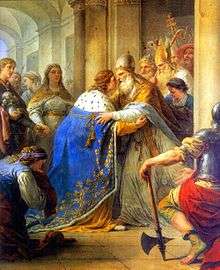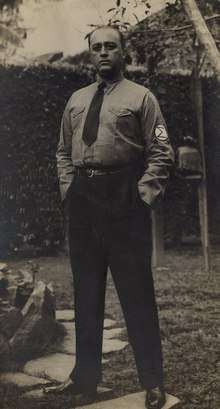Integralism

Integralism or integrism is used in the context of Catholicism to refer to an organization of the state which rejects "the separation of politics from concern with the end of human life, holding that political rule must order man to his final goal."[1] Though less commonly referred to in modern theology, integralism defines the social order of medieval Christendom and is part of the social teaching of the Catholic Church.[2]
Catholic integralism
Catholic integralism (also called integrism) is an "anti-pluralist" trend in Catholicism; the Catholic integralism born in 19th-century Spain, France, and Italy was a movement that sought to assert a Catholic underpinning to all social and political action, and to minimize or eliminate any competing ideological actors, such as secular humanism and liberalism.[3]
Catholic integralism does not support the creation of an autonomous "Catholic" state church, or Erastianism (Gallicanism in French context). Rather it supports subordinating the state to the moral principles of Catholicism. Thus it rejects separating morality from the state and favours Catholicism as the proclaimed religion of the state.[4]
Catholic integralism appeals to the teaching on the subordination of temporal to spiritual power of medieval popes such as Pope Gregory VII and Pope Boniface VIII. But Catholic Integralism in the strict sense came about as a reaction against the political and cultural changes which followed the Enlightenment and the French Revolution.[5] The 19th-century papacy challenged the growth of liberalism (with its doctrine of popular sovereignty) as well as new scientific and historical methods and theories (which were thought to threaten the special status of the Christian revelation). Pope Pius IX condemned a list of liberal and Enlightenment ideas in his Syllabus of Errors. The term integralism was applied to a Spanish political party founded about 1890, which based its programme on the "Syllabus". Catholic integralism reached its "classical" form in the reaction against modernism. After the papal condemnation of modernism in 1907, "integral Catholics", encouraged by Pope Pius X, sought out and exposed any co-religionist whom they suspected of modernism or liberalism. An important integralist organization was the Sodalitium Pianum, known in France as La Sapinière (fir plantation), which was founded in 1909 by Umberto Benigni.[6]
Catholic integralism suffered a decline after the Second Vatican Council, due to a lack of support from the Catholic hierarchy; during that time, other ideas had been proposed about the relation between the church and state. However, even the Second Vatican Council finally sided with the integralist understanding in some ways, stating in Dignitatis humanae that the council "leaves intact the traditional teaching of the duty which the state owes to the Church", namely, recognition of the church as the state religion, unless it would be a detriment to the common good. However, the document also affirmed personal freedom of conscience and freedom from coercion, and in the heyday after the council this became the focus of theological discourse, to the exclusion of the traditional teaching on church–state relations. In the post-conciliar period, Catholic integralism came to be supported mainly by traditionalist Catholics such as those associated with the Society of St. Pius X and Tradition, Family and Property, and lay Catholics, though some clergy still supported it in theory, if not vociferously. In recent years, however, a "revived Catholic integralism" has been noted among the younger generation of Catholics writing for websites such as The Josias.[7] Integralism could be said to merely be the modern continuation of the traditional Catholic conception of church–state relations elucidated by Pope Gelasius I and expounded upon throughout the centuries up to the Syllabus of Errors, which definitively condemned the idea that the separation of church and state is a moral good.
Scholars have drawn parallels between Catholic integralism and a view held by a minority in the Reformed churches, Christian reconstructionism.[8][9] In the National Catholic Reporter, Joshua J. McElwee stated that both Catholic integralists and Reformed Christian reconstructionists have created a non-traditional ecumenical alliance to achieve the goal of establishing a "theocratic type of state".[10][11]
French integralism
Integralism is particularly associated with the French Action Française movement founded by Charles Maurras.
Portuguese integralism
Integralismo Lusitano (Lusitanian Integralism) was the integralist movement of Portugal, founded in 1914. Portuguese integralism was traditionalist, but not conservative. It was against parliamentarism and, instead, it favored decentralization, national syndicalism, Catholicism and the monarchy.[12]
Brazilian integralism

Somewhat rooted in the Portuguese integralist tradition, the Brazilian integralist movement led by Plínio Salgado – Ação Integralista Brasileira – was for some time the largest political party ever founded in Brazil, with over a million members, even though it lasted less than six years as a legally recognized organization.
Integralism and fascism
Critics and opponents of integralism argue that the movement can be associated with fascism (especially in South America), although there exist deep points of disagreement: integralism stresses trade unionism and localism while fascism defends a centralist state; the traditionalist and Catholic foundation of integralist ideas against the often secular and anti-clerical, and modernist philosophical basis of fascism.[13]
Integralism and leftism
Some liberal Catholics such as John Zmirak have criticized contemporary Catholic integralists as enemies of "religious liberty".[14] However, others assert that this paints a false picture of integralism.[15]
See also
References
- ↑ Waldstein, Pater Edmund. Integralism in Three Sentences
- ↑ Waldstein, Edmund (3 March 2016). "Integralism and Gelasian Dyarchy". The Josias. Retrieved 12 April 2017.
- ↑ Kertzer, David I. Comrades and Christians: religion and political struggle in Communist Italy. 1980, page 101-2; Krogt, Christopher van der. Catholic Fundamentalism or Catholic Integralism?
- ↑ Krogt, Christopher van der. Catholic Fundamentalism or Catholic Integralism?
- ↑ Krogt, Christopher van der. Catholic Fundamentalism or Catholic Integralism? page 125
- ↑ Krogt, Christopher van der. Catholic Fundamentalism or Catholic Integralism? pages 124–125
- ↑ Douthat, Ross (8 October 2016). Among the Post-Liberals. The New York Times. Retrieved 16 July 2017
- ↑ Spadaro, Antonio; Figueroa, Marcelo (2017). "Evangelical Fundamentalism and Catholic Integralism in the USA: A surprising ecumenism". La Civiltà Cattolica. Retrieved 20 July 2017.
- ↑ Glatz, Carol (13 July 2017). "Journal: Strip religious garb, fundamentalist tones from political power". Catholic News Service. Retrieved 20 July 2017.
- ↑ McElwee, Joshua J. (13 July 2017). "Italian Jesuit magazine criticizes political attitudes of some US Catholics". National Catholic Reporter. Retrieved 20 July 2017.
- ↑ Faggioli, Massimo (18 July 2017). "Why Should We Read Spadaro on 'Catholic Integralism'?". Commonweal. Retrieved 20 July 2017.
- ↑ Kallis, Aristotle A. Fascism Reader, p. 313-317 2003 Routledge
- ↑ Payne, Stanley A History of Fascism, 1914–1945, Routledge 1996.
- ↑ Zmirak, John (5 August 2017). "Catholics Reject Freedom at Their Own Peril". The Stream. Retrieved 12 April 2017.
- ↑ Sanchez, Gabriel (11 February 2015). "Some Clarifications on Catholic Integralism". Opus Publicum. Retrieved 12 April 2017.